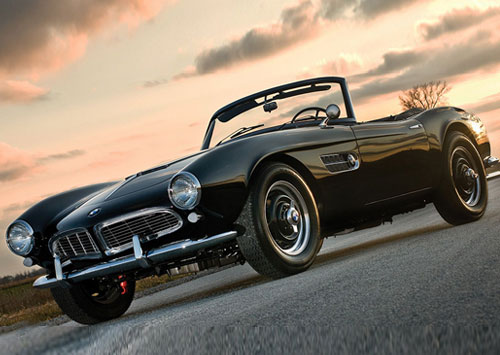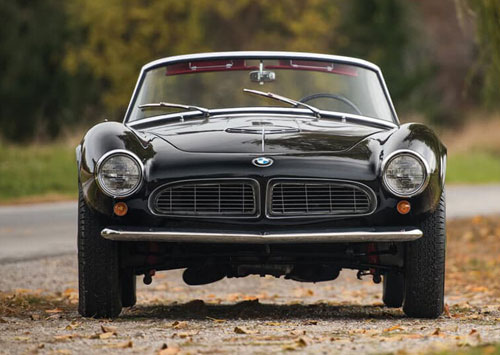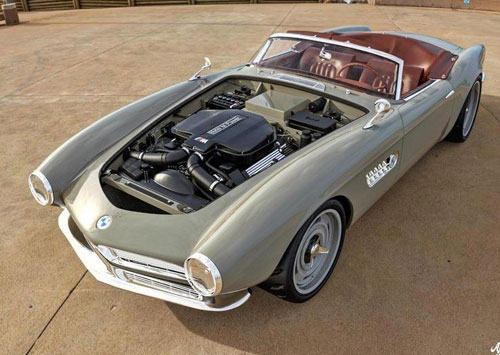
Join us and be an active member and benefit from our services
BMW 507
The BMW 507 is a roadster that was produced by BMW from 1956 to 1959. Initially intended to be exported to the United States at a rate of thousands per year, it ended up being too expensive, resulting in a total production figure of 252 cars and heavy financial losses for BMW.
The BMW 507 was conceived by U.S. automobile importer Max Hoffman who, in 1954, persuaded the BMW management to produce a roadster version of the BMW 501 and BMW 502 saloons to fill the gap between the expensive Mercedes-Benz 300SL and the cheap and underpowered Triumph and MG sports cars. BMW engineer Fritz Fiedler was assigned to design the rolling chassis, using existing components wherever possible. Early body designs by Ernst Loof were rejected by Hoffman, who found them to be unappealing. In November 1954, at Hoffman's insistence, BMW contracted designer Albrecht von Goertz to design the BMW 503 and the 507.
Thirty-four Series I 507s were built in 1956 and early 1957.[8] These cars had welded aluminium fuel tanks of 110 litres (29.1 US gal) capacity behind the rear seats.[7] These large tanks limited both boot space[7] and passenger space, and gave off the smell of fuel inside the car when the soft top was up or the hardtop was in place.[8] Series II and later 507s had fuel tanks of 66 litres (17.4 US gal) capacity under the boot, shaped around the space for the spare tyre.
The 507 frame was a shortened 503 frame, the wheelbase having been reduced from 2,835 millimetres (111.6 in) to 2,480 millimetres (98 in). Overall length was 4,385 millimetres (172.6 in), and overall height was 1,257 millimetres (49.5 in).[3] Curb weight was about 1,330 kilograms (2,930 lb). The body was almost entirely hand-formed of aluminium, and no two models were exactly the same. 11 cars were sold with an optional hand-fabricated removable hardtop. Because of the car-to-car differences, each hardtop fits only the car for which it was made.
The front suspension had parallel double wishbones with torsion bar springs and an anti-roll bar. The rear suspension had a live axle, also sprung by torsion bars, and located by a Panhard rod and a central, transverse A-arm to control acceleration and braking forces. The brakes were Alfin drum brakes of 284.5 mm (11.2 in) diameter, and power brakes were optional. Late-model 507s had front Girling disc brakes.[citation needed] and Pirelli 185VR16 Cinturato radial tyres.
The engine was BMW's aluminium alloy OHV V8, of 3,168 cubic centimetres (193.3 cu in) displacement, with pushrod-operated overhead valves. It had two Zenith 32NDIX two-barrel carburetors, a chain-driven oil pump, high-lift cams, a different spark advance curve, polished combustion chamber surfaces, and a compression ratio of 7.8:1, yielding 150 metric horsepower (110 kW) DIN at 5,000 rpm. It was mated to a close ratio four-speed manual transmission. The standard rear-end ratio was 3.70:1, but ratios of 3.42:1 and 3.90:1 were optional. A contemporary road test of a 507 with the standard 3.70:1 final drive was reported in Motor Revue, stating a 0–100 km/h (0–62 mph) acceleration time of 11.1 seconds and a top speed of 122 mph.
The 507 made its debut at the Waldorf-Astoria Hotel in New York in the summer of 1955. Production began in November 1956. Hoffman intended the 507 to sell for about $5,000, which he believed would allow a production run of 5,000 units a year. Instead, high production costs pushed the price in Germany to DM 26,500 then DM 29,950.[note 1] This drove the U.S. price initially to $9,000 then ultimately $10,500 ($94,200 today). Some of the prominent buyers were John Derek, Elvis Presley who owned two, Hans Stuck, and Georg "Schorsch" Meier. Despite the celebrity owners, the 507 never reached more than 10% of the sales volume achieved by Mercedes-Benz 300SL
BMW had intended for 507 to revive the company's sporting image, but the higher production cost led the company to the verge of bankruptcy. BMW lost money on each 507 built and resulted in the company's losses of DM 15 million for 1959.The company's losses led to the capital infusion from Herbert Quandt in order to prevent the bankruptcy. The launch of the new models, BMW 700 and 'New Class' 1500 helped the company recover financially.
| # | BMW | 507 |
|---|---|---|
| 1 | Produced | 1956–1960 |
| 2 | Engine | 3168 cc M507/1 V8 |
| 3 | Class | Grand tourer |
| 4 | Assembly | Germany: Bavaria, Milbertshofen |
| 5 | Body Style | 2-door convertible |
| 6 | Body Layout | FR layout |
| 7 | Transmission | 4-speed ZF manual |
| 8 | Wheelbase | 2,480 mm (97.6 in) |
| 9 | Length | 4,380 mm (172.4 in) |
| 10 | Width | 1,650 mm (65.0 in) |
| 11 | Height | 1,257 mm (49.5 in) |
| 12 | kerb weight | 1,330 kg (2,932 lb) |





